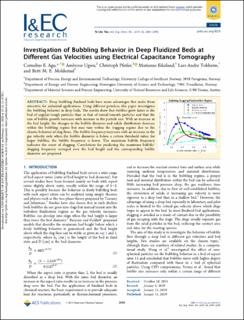| dc.contributor.author | Agu, Cornelius Emeka | |
| dc.contributor.author | Ugwu, Ambrose | |
| dc.contributor.author | Pfeifer, Christoph | |
| dc.contributor.author | Eikeland, Marianne Sørflaten | |
| dc.contributor.author | Tokheim, Lars-André | |
| dc.contributor.author | Moldestad, Britt Margrethe Emilie | |
| dc.date.accessioned | 2020-03-06T09:33:12Z | |
| dc.date.available | 2020-03-06T09:33:12Z | |
| dc.date.created | 2019-05-01T15:28:20Z | |
| dc.date.issued | 2019 | |
| dc.identifier.citation | Industrial & Engineering Chemistry Research. 2019, 58 (5), 2084-2098. | en_US |
| dc.identifier.issn | 0888-5885 | |
| dc.identifier.uri | https://hdl.handle.net/11250/2645712 | |
| dc.description | This is an open access article published under an ACS AuthorChoice License, which permits copying and redistribution of the article or any adaptations for non-commercial purposes. | en_US |
| dc.description.abstract | Deep bubbling fluidized beds have some advantages that make them attractive for industrial applications. Using different powders, this paper investigates the bubbling behavior in deep beds. The results show that bubbles grow faster in the bed of angular/rough particles than in that of round/smooth particles and that the rate of bubble growth increases with increase in the particle size. With an increase in the bed height, the changes in the bubble diameter and solids distribution decrease within the bubbling regime but may vary within the slugging regime due to the chaotic behavior of slug flows. The bubble frequency increases with an increase in the gas velocity only when the bubble diameter is below a certain threshold value; for larger bubbles, the bubble frequency is lower. The maximum bubble frequency indicates the onset of slugging. Correlations for predicting the maximum bubble/slugging frequency averaged over the bed height and the corresponding bubble diameter are proposed. | en_US |
| dc.language.iso | eng | en_US |
| dc.rights | Navngivelse-Ikkekommersiell 4.0 Internasjonal | * |
| dc.rights.uri | http://creativecommons.org/licenses/by-nc/4.0/deed.no | * |
| dc.title | Investigation of bubbling behavior in deep fluidized beds at different gas velocities using electrical capacitance tomography | en_US |
| dc.type | Peer reviewed | en_US |
| dc.type | Journal article | en_US |
| dc.description.version | publishedVersion | en_US |
| dc.source.pagenumber | 2084-2098 | en_US |
| dc.source.volume | 58 | en_US |
| dc.source.journal | Industrial & Engineering Chemistry Research | en_US |
| dc.source.issue | 5 | en_US |
| dc.identifier.doi | 10.1021/acs.iecr.8b05013 | |
| dc.identifier.cristin | 1694936 | |
| cristin.ispublished | true | |
| cristin.fulltext | original | |
| cristin.qualitycode | 2 | |

